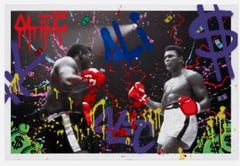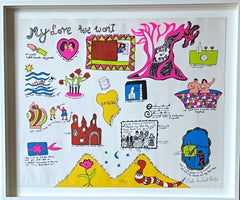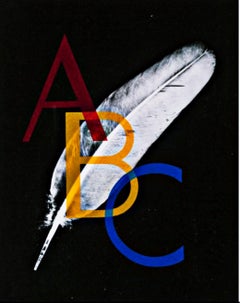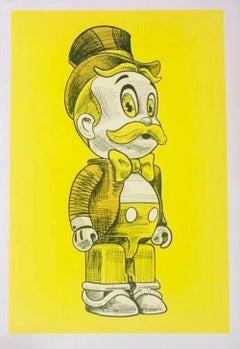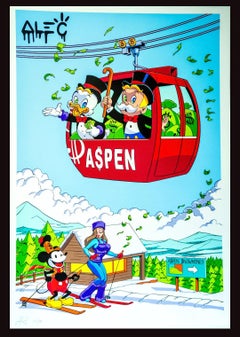Alec Monopoly Prints and Multiples
In his sculptures, murals, prints and canvases, Alec Monopoly (born Alec Andon) invites his viewers to simultaneously critique and buy into ideas of celebrity, money, and fame.
Monopoly often depicts Rich Uncle Pennybags, the suited mascot of the board game that inspired the artist’s moniker. The mustachioed character, who frequently carries a money bag or demonstrates other conspicuous markers of wealth throughout the artist’s wry work, becomes a stand-in for capitalist greed.
Monopoly has also incorporated pop culture figures and characters including Bob Dylan, Patrick Bateman, Scrooge McDuck and Richie Rich into his street art practice. He has enjoyed exhibitions in Miami, Moscow and other cities.
Find original Alec Monopoly sculptures, prints and other art on 1stDibs.
(Biography provided by Baldwin Contemporary)
2010s Alec Monopoly Prints and Multiples
Lithograph, Screen
1960s Pop Art Alec Monopoly Prints and Multiples
Screen, Pencil, Lithograph, Mixed Media
1970s Surrealist Alec Monopoly Prints and Multiples
Mixed Media, Pencil, Lithograph, Screen
1980s Art Deco Alec Monopoly Prints and Multiples
Lithograph, Screen
1970s Pop Art Alec Monopoly Prints and Multiples
Lithograph, Paper, Screen
1970s Pop Art Alec Monopoly Prints and Multiples
Lithograph, Screen
1980s Abstract Expressionist Alec Monopoly Prints and Multiples
Lithograph, Screen, Pencil
1970s Contemporary Alec Monopoly Prints and Multiples
Lithograph, Screen
1980s Pop Art Alec Monopoly Prints and Multiples
Pencil, Lithograph, Screen
Early 2000s Realist Alec Monopoly Prints and Multiples
Metal
1970s Modern Alec Monopoly Prints and Multiples
Lithograph, Screen
1990s Contemporary Alec Monopoly Prints and Multiples
Lithograph, Screen
1980s Contemporary Alec Monopoly Prints and Multiples
Lithograph, Screen, Intaglio
2010s Pop Art Alec Monopoly Prints and Multiples
Giclée
2010s Pop Art Alec Monopoly Prints and Multiples
Giclée
2010s Pop Art Alec Monopoly Prints and Multiples
Archival Paper, Giclée
2010s Pop Art Alec Monopoly Prints and Multiples
Giclée
2010s Pop Art Alec Monopoly Prints and Multiples
Giclée
2010s Alec Monopoly Prints and Multiples
Screen
21st Century and Contemporary Street Art Alec Monopoly Prints and Multiples
Ceramic
21st Century and Contemporary Street Art Alec Monopoly Prints and Multiples
Wood
Alec Monopoly prints and multiples for sale on 1stDibs.
Artists Similar to Alec Monopoly
- What does Alec Monopoly do?1 Answer1stDibs ExpertApril 16, 2024What Alec Monopoly does is create art and work as a DJ. He produces sculptures, murals, prints and canvases that invite his viewers to simultaneously critique and buy into ideas of celebrity, money and fame. Monopoly often depicts “Rich Uncle” Pennybags, the suited mascot of the board game that inspired the artist's moniker. The mustachioed character, who in the artist’s wry work frequently carries a money bag or demonstrates other conspicuous markers of wealth, acts as a stand-in for capitalist greed. On 1stDibs, find an assortment of Alec Monopoly art.
- 1stDibs ExpertApril 26, 2024The paint that Alec Monopoly uses is typically spray paint. The American artist also incorporates varnishes and epoxies into many of his paintings. In addition, he is well known for utilizing stencils when producing his works. On 1stDibs, shop a range of Alec Monopoly art from some of the world's top galleries and dealers.
- 1stDibs ExpertApril 26, 2024Alec Monopoly got famous through his street art. In 2006, he relocated from New York City to Los Angeles, a city that had plenty of billboards for him to adorn with his work, which often depicted Rich Uncle Pennybags, the suited mascot of the board game that inspired the artist's moniker. Relating to greed and consumerism, the themes of his works soon attracted interest, and his practice of wearing a disguise created a buzz around his work. By 2010, he had gained enough fame to host his first-ever exhibition, which took place in New York City. Find a selection of Alec Monopoly art on 1stDibs.
- 1stDibs ExpertMarch 25, 2024The reasons why Alec Monopoly covers his mouth have changed over the course of his career. Initially, the artist covered his face to conceal his identity out of fear of arrest for his street art. In 2019, Monopoly allowed his face to be photographed, but he often continued to cover his mouth in photographs. He explained that he did so to represent the fact that he prefers to speak through his work rather than through words. Explore a collection of Alec Monopoly art on 1stDibs.
- 1stDibs ExpertSeptember 28, 2021An Alec Monopoly painting could cost you at least $50,000 to $100,000. It can go much higher, depending on the style, its condition and much more. Alec Monopoly is a well-known street artist and his work, which is primarily done in a variety of media, frequently features the character from the popular board game Monopoly, Mr. Monopoly, and often communicates a criticism of extreme capitalism. Find a collection of Alec Monopoly paintings on 1stDibs.
